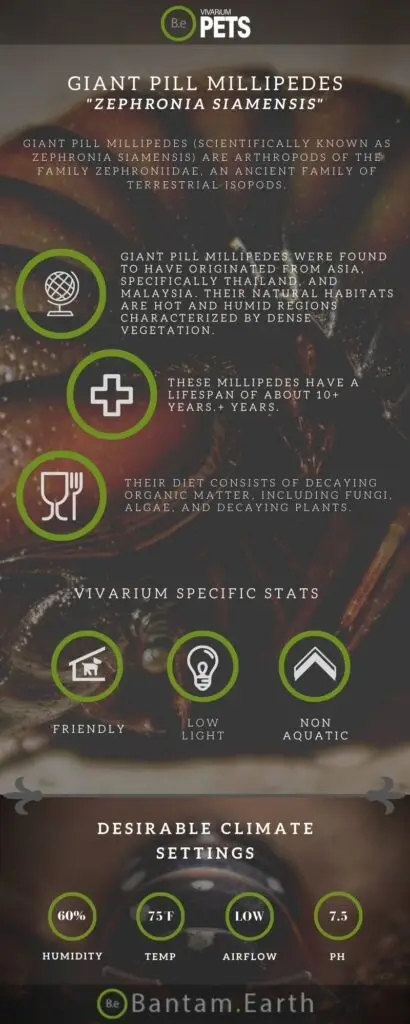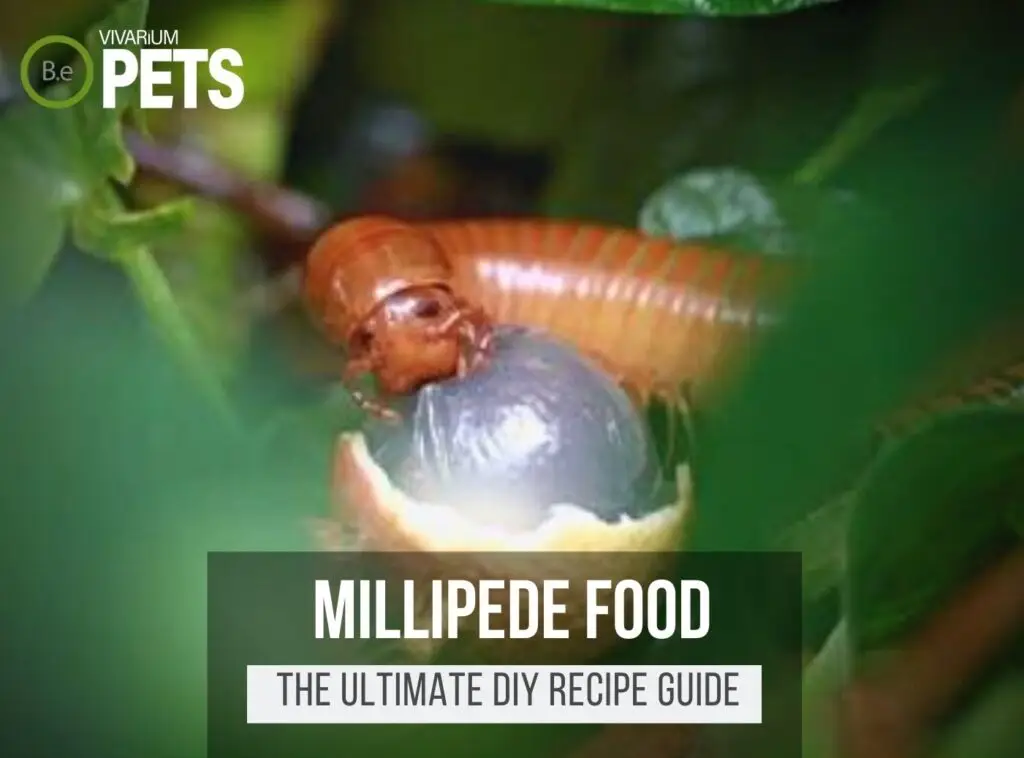Zephronia siamensis, or Giant Pill Millipedes, are an amazingly larger species of their miniature relative Glomeris marginata (Pill Millipedes).
These humble millipedes are charismatic and becoming increasingly popular to keep as terrarium pets.
To ensure the health and well-being of these incredible creatures, it’s important to know how to properly care for them in captivity.
In this guide, we’ll provide you with all the tips and tricks necessary to successfully raise and maintain this small millipede population.
| Characteristics: | |
|---|---|
| Common Name | Giant Pill Millipede |
| Family Name | Zephroniidae |
| Scientific Name | Zephronia siamensis |
| Use | Cleaning, Aerating Soil, Pets |
| Temperament | Non-aggressive |
| Lifespan | 10+ Years |
| Diet | Detritivore |
| Adult Size | 5.08 cm |
| Breeding Type | Egg Layer |
| Care Level | Easy |
| Minimum Tank Size | 5-10 Gallons |
| pH | 7.5-8.5 |
| Hardness | Moderate |
| Temperature | 70-85°F |
Table Of Contents:
ToggleWhat Are Giant Pill Millipedes?
Giant Pill Millipedes (scientifically known as Zephronia siamensis) are arthropods of the family Zephroniidae, an ancient family of terrestrial isopods.
The common name ‘Giant Pill Millipede’ originates from their unique shape – the cylindrical body and single pair of legs give them the appearance of a large pill.
They are native to the forests of Southeast Asia, specifically Thailand, Laos, and Vietnam, and are typically found in moist, humus-rich soil.
Due to human activities and urbanization, Zephronia siamensis is now considered a vulnerable species.
What Do Giant Pill Millipedes Look Like?
Zephronia siamensis is a unique species of millipedes known for its vibrant colors and pronounced body size.
The adult individuals of this species can reach up to a length of around 2 inches.
Their exoskeletons are usually a bright yellow or orange, with black markings on the sides, while their undersides often have a brownish hue.
Giant Pill Millipedes are generally quite solid in build, with thick exoskeletons that protect them from predators.
They have several long, slender legs and a pair of antennae on their heads that they use to sense their environment.
Additionally, to the sides of their heads are unique shapes and patterns of bumps known as tubercles, which allow them to recognize each other.
Benefits Of Using Giant Pill Millipedes
Giant Pill Millipedes are a great addition to any vivarium type due to their captivating appearance, interesting behaviors, and harmless nature.
As an omnivore, Zephronia siamensis can help keep a terrarium clean by feeding on both plant and animal matter, such as dead plants, decaying wood, and small insects.
With the proper environment and feeding, these millipedes can also be bred in captivity, adding greater diversity to the ecology of an enclosure.
In addition, their harmless nature makes them the perfect pet for anyone looking for an easy-to-care-for exotic species.


Giant Pill Millipede Facts
Giant Pill Millipedes are nocturnal arthropods that feed on decaying plants and other organic matter.
They have a lifespan of up to 10 years, a generally docile temperament, and are easy to breed in captivity.
Another interesting feature of Zephronia siamensis is its ability to curl into a tight ball to protect itself from predators.
Habitat
Giant Pill Millipedes were found to have originated from Asia, specifically Thailand, and Malaysia.
Their natural habitats are hot and humid regions characterized by dense vegetation.
They are usually found in deciduous forests and thick undergrowth in lowland areas.
They are relatively inactive creatures, moving slowly in search of food and rarely interacting with other Millipedes.
During the day, they hide in crevices or underneath the bark of trees, or in leaf litter to find shelter from the sun. At night, however, they emerge to forage for food and breed.
Diet
The Giant Pill Millipede is an omnivore, meaning it feeds on both plant and animal matter.
These millipedes primarily feed on organic matter found naturally in the soil and leaf litter.
Zephronia siamensis tend to eat decaying organic matter such as fungi, moss, fruit, roots, and bark.
They also will feed on small creatures that they encounter such as insect larvae, earthworms, and even small decaying mammals.
Temperament
Giant Pill Millipedes are a relatively docile and non-aggressive species of arthropod.
They rarely attempt to bite or pinch humans, and will likely remain calm in the presence of people, other animals, and even other Giant Millipedes.
The degree of their non-aggression is partly due to their low mobility and slow reaction times, as they move quite slowly and lack the agility necessary to effectively hunt or attack prey.
However, if they feel threatened or are mishandled, they may still attempt to defend themselves by raising their hard exoskeletons into an arch, or by secreting an unpleasant and sticky fluid.
As long as they aren’t disturbed, Giant Pill Millipedes generally behave peacefully in the presence of humans and other animals.
Lifespan
Giant Pill Millipedes can live up to 10 years with proper care. They are also capable of reproducing, but the number of eggs laid is usually quite low.
Zephronia siamensis start as small larvae after hatching from the egg.
After approximately two months, the larvae will molt several times until they’re finally an adult.
The adult Giant Pill Millipedes will usually stay in the same location and feed off decaying vegetation, as well as occasional insects.
As they age, they start to slow down and become less active. At around 4-5 years of age, females are capable of reproducing.
They will lay a small number of eggs and bury them in the soil, as this is where the larvae will hatch and feed before becoming adult millipedes.
The juveniles will molt several times, eventually reaching adulthood after two months.
Breeding
Giant Pill Millipedes mate and reproduce through a process called sperm-casting.
During this process, males will produce a string of sperm and lay it on the ground.
The female will pick up the sperm with her genital openings and use them to fertilize her eggs.
After the eggs have been fertilized, the female will lay them in a nest or soil pocket and the young will emerge 12-14 days later.
These young Pill Millipedes look like small clones of the adults, just a few millimeters in length.
By the time the juvenile millipedes reach adulthood, they have molted up to 6 to 8 times.
Zephronia siamensis reach sexual maturity at about 10–12 months of age, although some of the larger species can take up to 24 months.
Where To Find Giant Pill Millipedes
Giant Pill Millipedes can be found in South East Asia and Myanmar, particularly in tropical forests and rainforests.
They are most commonly found on the ground usually under leaf litter, stones, and dead trees.
In terms of buying them, these millipedes can be difficult to find for sale online, but some reputable sellers offer them.
It is important to research the seller before making a purchase, to make sure that they are verified and experienced with the species.
It is also important to note that these millipedes cannot survive in temperatures lower than 15 degrees Celsius.
It is best to collect them right before you return them to a proper captive habitat.
Giant Pill Millipede Care
Caring for Giant Pill Millipedes involves providing a suitable environment including an appropriate substrate, food, shelter, and temperature.
I also recommend ensuring good health through regular cleaning and disease management.
It’s also important to keep them in the correct numbers and to know the warning signs of potential illnesses and diseases.
With the right care, these amazing creatures can thrive in captivity.
Tank Requirements
The ideal environment for Giant Pill Millipedes requires a terrarium that has proper ventilation, as this helps keep a consistent temperature range.
For these animals, an ideal temperature range is between 70 to 80 degrees Fahrenheit.
In terms of humidity levels, an ideal environment should be within the range of 60 to 80%.
The pH should be on the neutral side, with a range between 6.5 and 7.5. The water hardness should remain between 2 and 8 KH.
An ideal terrarium substrate for Giant Pill Millipedes is moist, yet not wet.
One that is commonly used is coco fiber soil mixed with either peat moss or leaf litter, as this helps maintain the required moisture and pH.
Proper terrarium lighting is also essential. While these millipedes are largely nocturnal, they do still require UV lighting to help maintain their calcium levels.
A UV bulb should be provided that is either 7.0/10.0 or 8.0/10.0 for Giant Pill Millipedes.
What Do Giant Pill Millipedes Eat?
Feeding Giant Pill Millipedes is essential to their health and well-being in captivity.
It’s best to provide them with a diet of small invertebrates and other nutrient-rich foods.
Here is a list of things that you can feed your Giant Pill Millipedes:
- Small crickets
- Fruit flies
- Waxworms
- Chopped vegetables and fruits, such as apples, oranges, carrots, and green beans
- Dried commercial diets formulated for millipedes
It’s important to provide foods with a variety of nutritional values. Variety is key to ensuring a healthy diet for your pet millipedes.
Always provide fresh food and remove uneaten food to prevent mold and bacterial growth.
It’s also important to remember that millipedes are slow eaters, so you may want to give them several small meals throughout the day, rather than one large meal.
If you’re more of an avid hobbyist like myself, be sure to check out my ultimate DIY Millipede food guide. I give a more in-depth explanation of the best foods and my favorite recipe.
Best Tankmates For Giant Pill Millipedes
Giant Pill Millipedes are solitary creatures and don’t generally need or want to live with companions of their species.
They can, however, benefit from being kept with other arthropods that have similar needs.
Good tankmates for Zephronia siamensis include isopod species like Pill bugs, Cubaris, and Sow bugs.
All these animals are omnivorous, nocturnal, and thrive in similar humid environments as Giant Pill Millipedes.
Being able to watch these creatures interact is a fascinating and rewarding experience that no animal lover should miss out on.
With careful consideration, Giant Pill Millipedes can be kept with tankmates which will make for a healthy, happy, and vibrant environment.
Conclusion
With the right habitat and sufficient food, Giant Pill Millipedes will thrive in captivity.
Providing your Zephronia siamensis with proper care and attention is essential for their health and well-being, and with the information in this guide, you can do just that!
With a little bit of effort and dedication, you’ll quickly become a successful pet millipede caretaker.
Frequently Asked Questions
Giant pill millipedes (Zephronia siamensis) are detritivores, which means they primarily feed on decaying plant matter such as fallen leaves and dead wood. They are also known to consume fungi and other organic material found in soil.

